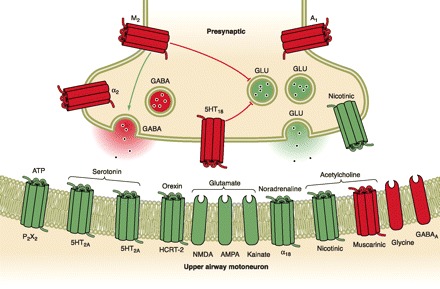Fig. 11.

Neurochemical control of the upper airway motoneurons. Presynaptic and postsynaptic excitatory and inhibitory neurochemicals influence the activity of upper airway motoneurons. Numerous excitatory (green) and inhibitory (red) receptor subtypes have been identified using molecular, protein, and physiological studies. Precise roles in motor functions (e.g., respiratory, speech, swallowing, etc.) have not been delineated for any of the receptors. While reductions in noradrenergic tone may contribute to reduced dilator muscle activity in non-REM sleep, the source of reduced motor tone in REM sleep has not been elucidated. Many of the identified receptor subtypes could be targeted pharmacologically, yet none of these is specific to pharyngeal dilator muscles and thus significant side effects including wakefulness are anticipated upon activation of the excitatory targets. M2, muscarinic; α, adrenergic; 5HT, serotonin; P2X2, purinergic; GLY, glycinergic; HCRT, hypocretinergic/orexinergic; GLU, glutamatergic; A, adenosinergic; GABA, γ-aminobutyric acid.
